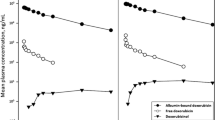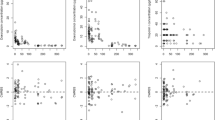Summary
Doxorubicin serum elimination kinetics were measured by HPLC in three different patient groups. A dose of (a) 30 mg/m2; (b) 50 mg/m2, and (c) 4×15 mg/m2 every 10 h was administered by bolus injection to (a) 10, (b) 6, and (c) 8 patients. The results obtained provided strong evidence for a nonlinear dependence of doxorubicin serum elimination on the dose and administration schedule used. Comparing the 15 and 30 mg/m2 dose there was no significant increase in early drug levels but a marked increase in terminal half-life. At doses higher than 30 mg/m2, however, there was a steep increase in early drug levels, too. Moreover a marked cumulation of the anthracycline in the central compartment following short-term (4×15 mg/m2 every 10 h) consecutive administration was found. To obtain an optimal concentration x time product by single bolus injection a dose equal or higher than 30 mg/m2 should be used. However, in this dose range a steep dose-dependent rise in early drug levels is to be expected. As early high serum levels correlate with congestive heart failure, administration schedules reaching effective concentration x time products without high peak levels such as continuous infusion or consecutive administration of low doses seem to be necessary.
Similar content being viewed by others
References
Benjamin RS, Wiernik PH, Bachur NR (1974) Adriamycin chemotherapy efficacy, safety and pharmacologic basis of an intermittent single high-dosage schedule. Cancer 33:19–27
Boston RC, Philips DR (1983) Evidence of possible dose-dependent doxorubicin plasma kinetics in man. Cancer Treat Rep 67:63–69
Creasy WA, Intosh LS, Brescia T, Odujiurin O, Aspnes GT, Muray E, Morsk JC (1976) Clinical effects and pharmacokinetics of different dosage schedules of adriamycin. Cancer Res 36:216–221
Creech RH, Catalano RB, Shark MK (1980) An effective low-dose adriamycin regimen as secondary chemotherapy for metastatic breast cancer patients. Cancer 46:433–437
Erb N, Erttmann R, Landbeck G (1986) A rapid chromatographic procedure for the determination of adriamycin, daunomycin and their 13-OH metabolites adriamycinol and daunomycinol. Cancer Chemother Pharmacol 17:53–55
Garnick MB, Weiss GR, Steele GD, Israel M, Schade I, Sack MJ, Frei E (1983) Clinical evaluation of long-term continuous infusion of doxorubicin. Cancer Treat Rep 64:133–142
Gessner T, Rotot J, Bolanowska W, Hoerni B, Durand M, Preisler H, Rustum J (1981) Effects of prior therapy on plasma levels of adriamycin during subsequent therapy. J Med 12:183–193
Gil P, Favre R, Durand A, Iliadis A, Cano PJ, Carcassone Y (1983) Time dependency of adriamycin and adriamycinol kinetics. Cancer Chemother Pharmacol 10:120–124
Jürgens H (1981) Ewing-Sarkom bei Kindern und Jugendlichen: Vorstellung der kooperativen Therapiestudie der Gesellschaft für pädiatrische Onkologie. Klin Pädiat 193:175–180
Legha SS, Benjamin RS, Mackay B, Yap HY, Wallace S, Ewer M, Blumenschein GR, Freireich EJ (1982) Adriamycin therapy by continuous intravenous infusion in patients with metastatic breast cancer. Cancer 49:1762–1766
Lotrich J, Bothe A, Zipoli T (1984) Constant infusion schedule for adriamycin: a phase I-II clinical trial of a 30-day schedule by ambulatory pump delivery system. J Clin Oncol 1:24–28
Mattson W, Borgström S, Lanberg T (1982) A weekly schedule of low-dose doxorubicin in treatment of advanced breast cancer. Clin Ther 5:193–203
Piazza E, Donelli MG, Broggini M, Jessa C, Natale N, Ottolenghi L, Marsoni S, Lioretti A, Mangioni C, Morasca L (1980) Early phase pharmacokinetics of doxorubicin (adriamycin) in plasma of cancer patients during single or multiple drug therapy. Cancer Treat Rep 64:845–854
Preisler HD, Gessner T, Azarnia N, Bolanowska W, Epstein J, Early AP, D'Arrigo P, Vogler R, Winton L, Chervenik P, Joyce R, Lee H, Steele R, Goldberg J, Gottlies A, Browman G, Miller K, Grunwald H, Larson R, Breuman J (1984) Relationship between plasma adriamycin levels and the outcome of remission induction therapy for acute non-lymphatic leukemia. Cancer Chemother Pharmacol 12:125–130
Ritch PS, Occhipinti SJ, Skramstad KS, Shackney SE (1982) Increased relative effectiveness of doxorubicin against slowly proliferating sarcoma 180 cells after prolonged drug exposure. Cancer Treat Rep 66:1159–1168
Robert J, Hoerni B, Vrignaund P, Lagarde C (1983) Early-phase pharmacokinetics of doxorubicin in non-Hodgkin Lymphoma patients. Dose-dependent and tissue dependent pharmacokinetic parameters. Cancer Chemother Pharmacol 10:115–119
Tipping S, Riggs CE, Egorin MJ, Whitacre M, van Echo DA, Aisner J, Badur NR (1982) Accelerated disappearance of doxorubicin and doxorubicinol from plasma following prior chemotherapy. Proc Am Soc Clin Oncol Abstract 132
Treuner J, Kaatsch P, Anger Y, Seipp A, Spaar H-J, Gerein V, Suder J, Niethammer D (1986) Ergebnisse der Behandlung von Rhabdomyosarkomen (RMS) bei Kindern. Ein Bericht der Cooperativen Weichteilsarkomstudie (CW-81) der Gesellschaft für Pädiatrische Onkologie. Klin Pädiat 198:208–217
Valdivieso M, Burgers MA, Ewer MS, Mackay B, Wallace S, Benjamin RS, Ali MK, Bodey GP, Freireich EJ (1984) Increased therapeutic index of weekly doxorubicin in the therapy of non-small cell lung cancer: a prospective, randomized study. J Clin Oncol 2:207–214
Vogelzang NJ, Ruane M, De Meester TR (1985) Phase I trial of an implanted battery-powered programmatic drug delivery system for continuous doxorubucin administration. J Clin Oncol 3:407–414
Weiss AJ, Manthel RW (1983) A hypothesis concerning the effect of changes in scheduling on the cardiotoxicity of adriamycin. Oncology 40:221–226
Young RC, Ozols RF, Myers CE (1981) The anthracycline antineoplastic drugs. New Engl J Med 305:139–153
Author information
Authors and Affiliations
Additional information
This study was supported by the “Hamburger Krebsgesellschaft e. V.” and the “Werner Otto-Stiftung Hamburg”
Rights and permissions
About this article
Cite this article
Erttmann, R., Erb, N., Steinhoff, A. et al. Pharmacokinetics of doxorubicin in man: dose and schedule dependence. J Cancer Res Clin Oncol 114, 509–513 (1988). https://doi.org/10.1007/BF00391502
Received:
Accepted:
Issue Date:
DOI: https://doi.org/10.1007/BF00391502




